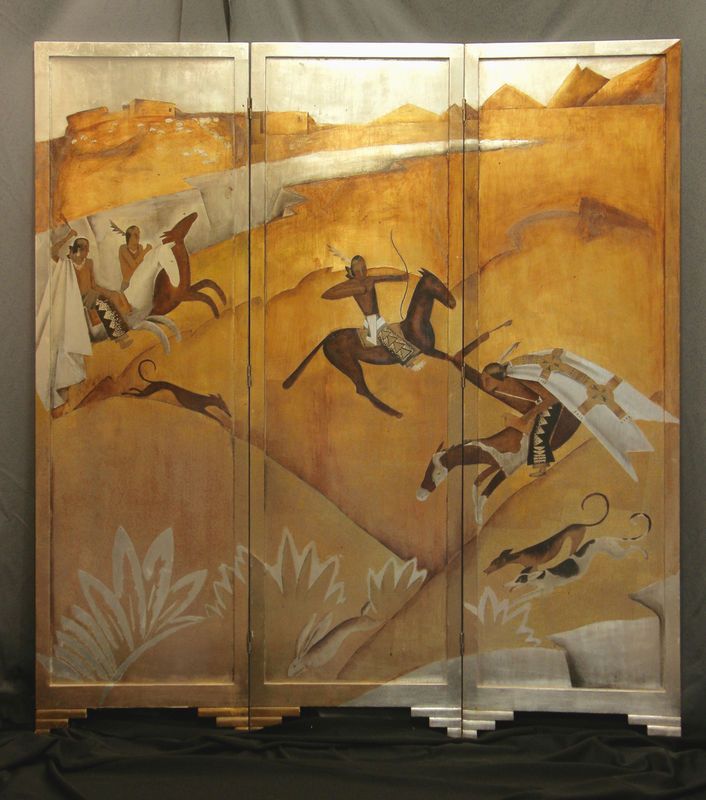
19th, 20th & 21st Century Fine Prints
707-546-7352 · fax 707-546-7924 · web: www.annexgalleries.com · email: artannex@aol.com
Rabbit Hunt by Esther Bruton

Rabbit Hunt
Esther Bruton
Rabbit Hunt
Esther Bruton
1896 - 1992 (biography)One of a pair of three-panel mural/screens by (Anne) Esther Bruton (1896-1992). These screens were purchased directly from the artist on November 22, 1977, with the final payment made on August 17, 1978.
The mural screen is titled Rabbit Hunt. It was one of 2 screens painted in 1929 while the artist was working at the Taos Pueblo. Bruton originally used aluminum leaf and Dutch metal, which tarnished, and the artist redid the screens in 1934 when she was learning to work with gold leaf for her murals for the Fairmont Hotel in San Francisco. The versos of the panels of Rabbit Hunt were painted over because Bruton felt they had deteriorated too much to repair.
Esther Bruton was born on October 17, 1896, in Alameda, California where she was raised with her sisters Margaret (1894-1983) and Helen (1898-1985). In 1917, she joined Margaret in New York where she studied with George Bridgeman at the Art Students’ League and commercial art at the New York School of Fine and Applied Arts. During this time she worked as an illustrator for Lord and Taylor.
In 1921, Bruton returned to the San Francisco Bay Area and gained employment as a fashion illustrator for I. Magnin department store. She traveled to Tahiti in 1924 remaining there for four months and, in 1925, she joined her sisters in a trip to Paris where they studied at the Academie de la Grande Chaumiere. It was late in the decade when Bruton decided to abandon commercial work entirely. She again joined her sisters for a 1929 trip to Taos, New Mexico to sketch the Taos Pueblo and these screens were conceived on this trip.
After returning to California in 1929, Esther, Margaret and Helen exhibited in San Francisco at the Beaux Arts Gallery and it is likely these screens were exhibited there. Throughout the Depression of the 1930s Esther continued to exhibit and her work received critical praise.
On February 12, 1930, the Bruton sisters opened an exhibition at Bullock’s Wilshire Gallery in Los Angeles. Art critic Arthur Millier noted, “The showing consists of paintings and drawings by Margaret, decorative screens in silver and gold, wood engraving and drypoints by Esther and wood-block prints by Helen.”
The San Francisco Call–Bulletin said of the exhibit of the San Francisco Art Association held at the Palace of the Legion of Honor on May 7, 1932, at which Esther received Honorable Mention for Eagle Dance, “So much good work by California artists is represented in the show that it is impossible to do it justice…Eagle Dance, a painting by Esther Bruton, is unsurpassed for sheer decorativeness.”
The screens were again shown in 1934 at the Amberg-Kirth Cooperative “Form and Function” Galleries in San Francisco at an exhibition of decorative work in connection with the Federal Housing Act in November 1934. The San Francisco Examiner commented on Esther’s work on November 13, “….Esther Bruton, one of the Bruton trio, has on exhibit an exquisite mosaic coffee table, and two screens—gold and silver leaf on wood panels. The subjects on the latter ¬American Hopi Indian rituals.”
Timothy L. Pfluger was commissioned in 1935 to design the Cirque cocktail lounge at the Fairmont Hotel in San Francisco and he, in turn, commissioned Esther to create the murals of circus images for the interior walls. These gilded paintings included bareback riders, elephants, zebras, tigers, etc. The Cirque was the first bar to open in San Francisco after prohibition. The murals still exist and the space may be reopened to the general public in the near future.
The Bruton sisters created a relief mural entitled The Peacemakers for the 1939 San Francisco based Golden Gate International Exposition. By this time the Bruton family had moved to Monterey, California following the lead of Margaret who had relocated to study with Armin Hansen. Esther Bruton was an active member of the California Society of Etchers and the San Francisco Art Association. She died in Monterey, California on August 31, 1992.
